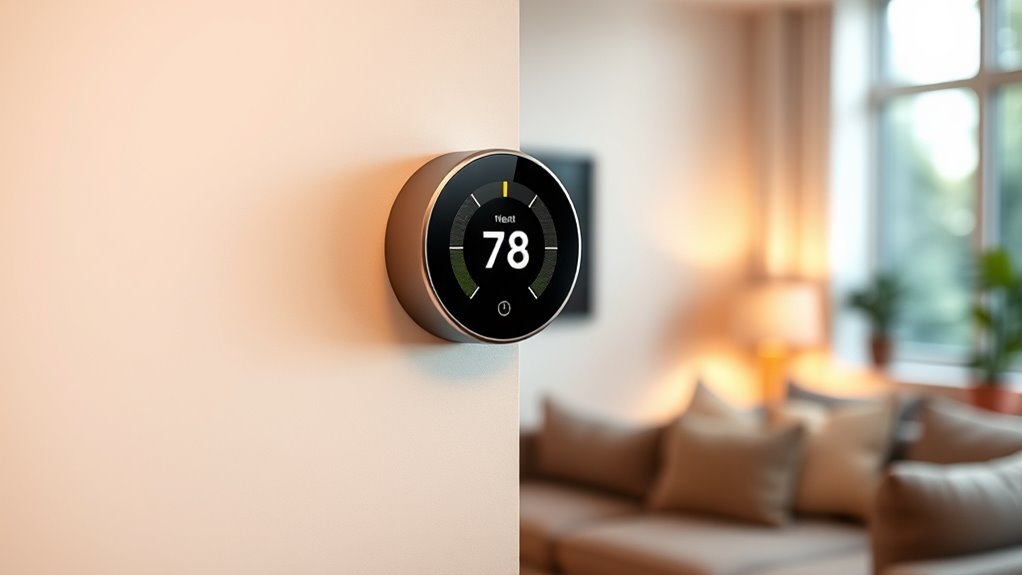If you’re looking for the best smart thermostats with learning features, I recommend checking out options like the Google Nest Learning Thermostat and ecobee Smart Thermostat models. These devices adapt to your schedule, save energy, and can be controlled remotely via apps. They often support multiple voice assistants and integrate seamlessly into smart home setups. Keep exploring to find the perfect fit for your home, and discover more about their features and benefits.
Key Takeaways
- The top smart thermostats feature advanced learning algorithms that adapt to your schedule for optimal comfort and energy efficiency.
- Compatibility with various HVAC systems and smart home ecosystems ensures seamless integration and easy installation.
- Many models include additional sensors and remote control options to manage hot/cold spots and maintain consistent temperatures.
- Energy-saving features like auto-schedule, occupancy detection, and Eco+ help reduce utility bills sustainably.
- User-friendly interfaces with high-definition touchscreens and customizable displays enhance overall convenience and control.
Google Nest Thermostat & Sensor (4th & 2nd Gen)
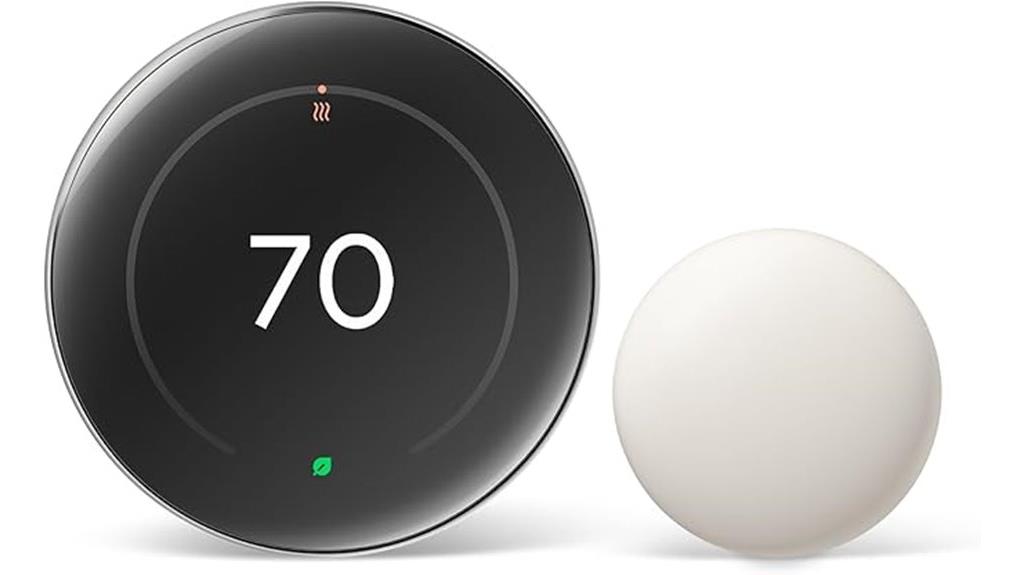
If you’re looking for a smart thermostat that combines sleek design with advanced functionality, the Google Nest Thermostat & Sensor (4th and 2nd Gen) is an excellent choice. I love its larger 60% display and Dynamic Farsight, which makes it easy to see from across the room. It works with most 24V systems, and installation is straightforward—no C wire needed in most homes. You can control it remotely via the Google Home app or through voice commands with Alexa, Siri, or Google Assistant. Plus, the included Nest Temperature Sensor helps manage hot and cold spots, boosting comfort and energy savings effortlessly.
Best For: homeowners seeking a stylish, easy-to-install smart thermostat compatible with most 24V systems and looking to optimize energy savings and comfort.
Pros:
- Large 60% display with Dynamic Farsight for easy visibility from across the room
- Easy DIY installation without the need for a C wire in most homes
- Seamless smart home integration via Google Home app and voice assistants like Alexa, Siri, and Google Assistant
Cons:
- May require additional sensors or setup for managing multiple rooms effectively
- Compatibility limited to 24V systems; may not work with some specialized heating/cooling setups
- Features like scheduling and sensor management might have a learning curve for new users
ecobee Smart Thermostat Essential with Wi-Fi
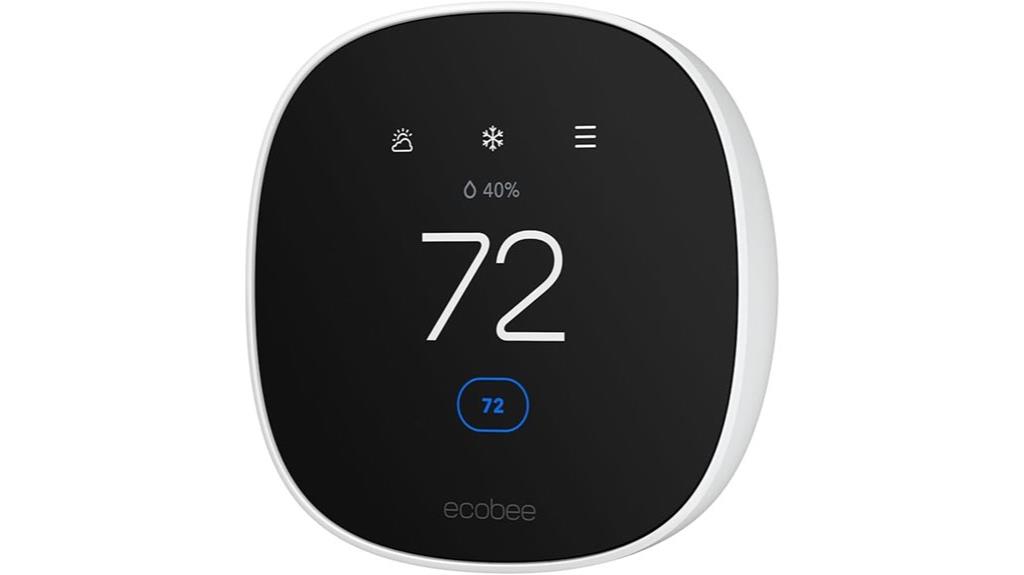
The ecobee Smart Thermostat Essential with Wi-Fi stands out as an excellent choice for homeowners seeking a budget-friendly, energy-efficient smart thermostat that’s easy to install and compatible with most HVAC systems. It’s Energy Star certified and works with 85% of systems, including gas, oil, electric, and heat pumps. Its simple round design features an LCD touch display and integrates seamlessly with Apple HomeKit, Google Assistant, and Alexa for voice control. Designed for straightforward DIY installation, it can save up to 23% annually on energy bills. With auto-scheduling and remote control through the app, it’s a reliable, modern solution for better home comfort and energy savings.
Best For: homeowners seeking an affordable, easy-to-install smart thermostat compatible with most HVAC systems and focused on energy savings.
Pros:
- Easy DIY installation with clear wiring instructions and optional Power Extender Kit
- Compatible with major smart home platforms like Apple HomeKit, Google Assistant, and Alexa
- Saves up to 23% annually on heating and cooling costs, providing quick return on investment
Cons:
- Some users experience initial wiring challenges and difficulty with customer support
- Limited advanced features compared to higher-end models
- Only supports most 24 VAC HVAC systems, so compatibility should be checked before purchase
Google Nest Learning Thermostat, 3rd Gen (2015)

For homeowners seeking a smart thermostat that learns your schedule and adjusts automatically, the Google Nest Learning Thermostat, 3rd Gen (2015), stands out as an excellent choice. It uses its Auto-Schedule feature to learn your preferences over time, eliminating manual programming. The Home/Away Assist automatically adjusts temperatures when you’re not home, saving energy. You can control it remotely via the Nest app for added convenience. With its sleek stainless steel design, it combines style with smart functionality. Just remember to check compatibility beforehand. Overall, it’s a reliable, energy-efficient option that makes maintaining a comfortable home effortless.
Best For: homeowners seeking a stylish, energy-efficient smart thermostat that learns their schedule and can be controlled remotely for maximum convenience.
Pros:
- Learns user preferences over time with Auto-Schedule, reducing manual programming
- Automatically adjusts temperatures with Home/Away Assist to save energy
- Remote control via the Nest app offers flexibility and ease of use
Cons:
- Requires checking system compatibility before purchase to ensure proper functioning
- Limited to compatible heating and cooling systems; not universal for all setups
- The sleek stainless steel design may be more expensive compared to basic thermostats
ecobee Smart Thermostat Premium with Sensors
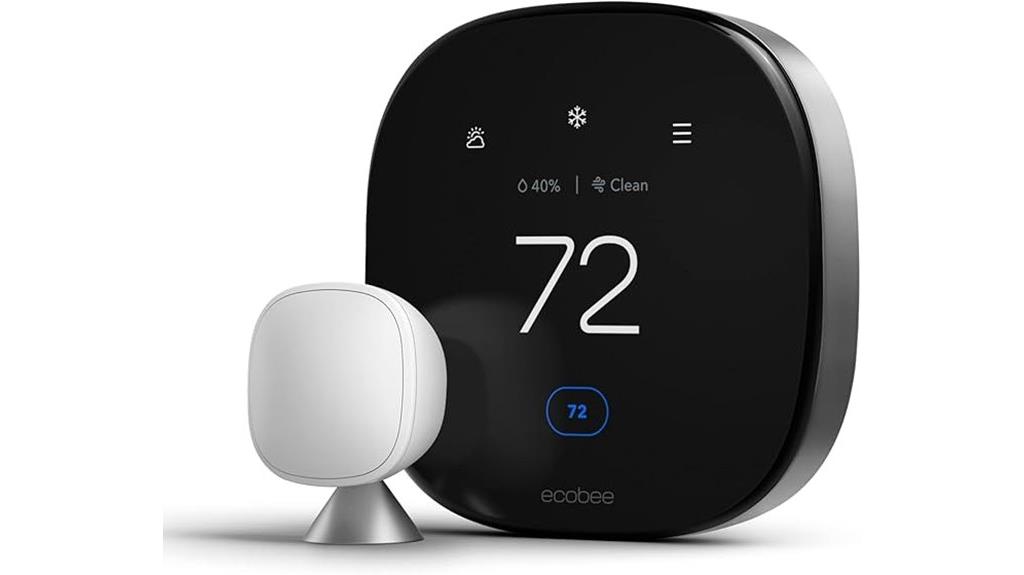
The ecobee Smart Thermostat Premium with Sensors stands out for homeowners seeking all-inclusive energy savings and enhanced home monitoring. It can save up to 26% annually on heating and cooling costs and is ENERGY STAR certified. The included SmartSensor adjusts temperature in key rooms, reducing hot or cold spots compared to a simple 72°F hold. It also features a built-in air quality monitor, alerts for poor air quality, and reminders to change filters. Additionally, it serves as a home monitoring hub with smoke detection and security alerts. Its sleek design, compatibility with most HVAC systems, and built-in voice control make it a versatile, intelligent choice for a smarter, more comfortable home.
Best For: homeowners seeking comprehensive energy savings, home monitoring, and smart thermostat features with seamless integration and voice control.
Pros:
- Up to 26% annual savings on heating and cooling costs with ENERGY STAR certification.
- Built-in air quality monitor, security alerts, and smoke detection for enhanced home safety.
- Compatible with most 24VAC HVAC systems and includes Power Extender Kit for easy installation.
Cons:
- Requires a subscription to ecobee Smart Security for certain advanced features.
- Apple Siri functionality needs an Apple home hub to operate.
- Advanced features like occupancy sensing and alerts may need setup and familiarity with smart home systems.
ecobee Smart Thermostat Enhanced with Voice Compatibility
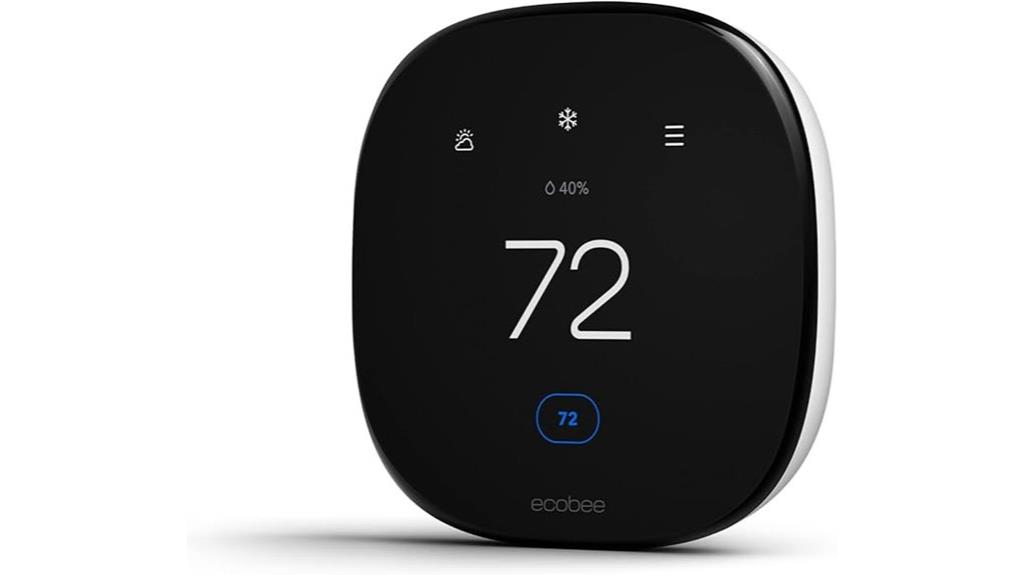
If you’re looking for a smart thermostat that seamlessly integrates voice control with energy-saving features, the ecobee Smart Thermostat Enhanced with Voice Compatibility is an excellent choice. It works with most 24 VAC HVAC systems, including gas, electric, and heat pumps, and supports Apple HomeKit, Alexa, Google Assistant, and more. Its sleek LCD display and app control make management easy, while features like occupancy detection and Eco+ optimize energy use. Installation is straightforward, especially with the included Power Extender Kit if you lack a C-wire. Overall, it offers reliable performance, smart home compatibility, and significant energy savings, making your home smarter and more comfortable.
Best For: homeowners seeking an energy-efficient, voice-compatible smart thermostat that easily integrates with popular smart home platforms and offers customizable comfort controls.
Pros:
- Seamless integration with Apple HomeKit, Alexa, Google Assistant, and other smart home systems
- Energy-saving features like Eco+ and occupancy detection that help reduce utility bills
- Easy installation with included Power Extender Kit and user-friendly app interface
Cons:
- Installation can be challenging for homes with complex wiring or without a C-wire, potentially requiring professional help
- Some users report initial setup difficulties related to HVAC system compatibility or wiring identification
- Slightly higher cost compared to basic thermostats, which may be a consideration for budget-conscious buyers
Google Nest Learning Thermostat (4th Gen, 2024) with Nest Temperature Sensor
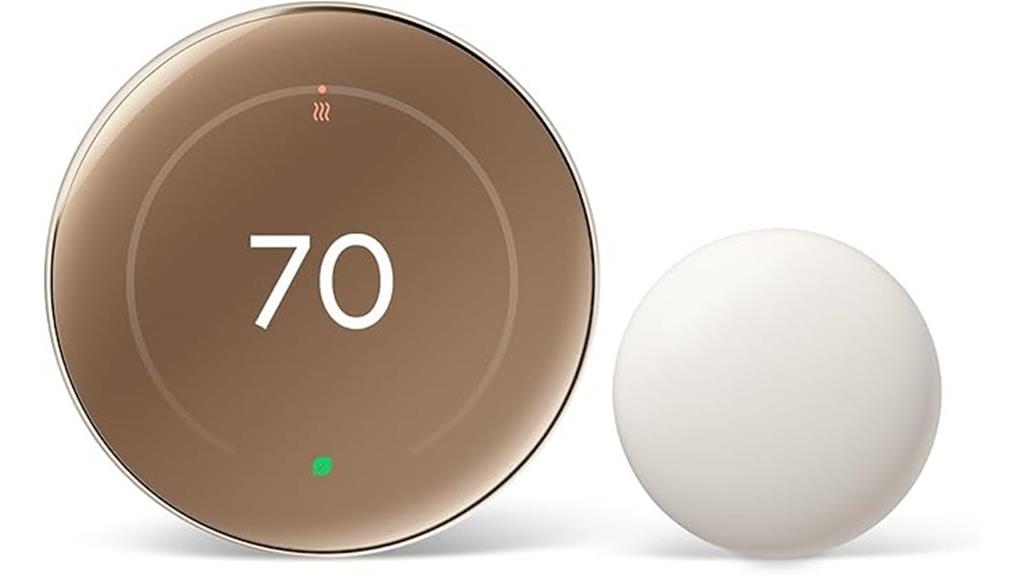
With its sleek design and advanced learning capabilities, the Google Nest Learning Thermostat (4th Gen, 2024) stands out as a top choice for homeowners seeking smart climate control that adapts to their routines. It features a polished gold finish, a larger display with Dynamic Farsight, and auto-adjusting brightness for easy readability. Compatible with most 24V systems and supporting Matter protocol, installation is quick and straightforward. The thermostat learns your preferences over time, optimizing comfort and energy savings. With the addition of the Nest Temperature Sensor, you can control specific rooms more precisely. Managed remotely via the Google Home app or voice commands, it combines style, intelligence, and efficiency seamlessly.
Best For: homeowners seeking an elegant, intelligent thermostat that learns their routines, offers precise room control, and integrates seamlessly with smart home systems.
Pros:
- Sleek, modern design with a polished gold finish and large display for easy viewing
- Advanced learning capabilities that optimize comfort and energy savings over time
- Supports multiple smart home ecosystems via Google Assistant, Alexa, and Siri integration
Cons:
- Higher price point compared to earlier Nest models
- Limited compatibility outside the US, particularly in the UK
- Privacy concerns associated with smart device data collection
Google Nest Thermostat, Programmable Wi-Fi Smart Thermostat

For homeowners seeking a smart thermostat that combines energy savings with easy remote control, the Google Nest Thermostat stands out. Its ENERGY STAR certification reflects efficiency, and it’s compatible with most heating, cooling, or zone-controlled systems—some may need a C wire. With Wi-Fi and Bluetooth, I can control it anytime via the Google Home app on my phone, tablet, or laptop. It creates personalized schedules and suggests tweaks to save energy. Plus, it detects system issues, sends alerts, and automatically turns down when I’m away. Its user-friendly design makes managing comfort and conserving energy simple, without sacrificing convenience.
Best For: homeowners seeking an ENERGY STAR certified, easy-to-control smart thermostat that enhances energy efficiency and offers remote management via Wi-Fi and Bluetooth.
Pros:
- Compatible with most heating, cooling, and zone-controlled systems, with optional C wire support.
- Remote control via the Google Home app on Android and iPhone for convenient adjustments from anywhere.
- Smart features include energy-saving schedules, savings suggestions, system issue alerts, and automatic temperature adjustments when home is empty.
Cons:
- May require a C wire or power accessory for certain system setups.
- No lock feature to prevent unauthorized changes.
- Some features or compatibility might need checking via the online Nest Compatibility Checker.
Google Nest Thermostat, Smart Wi-Fi Thermostat for Home

The Google Nest Thermostat stands out as an excellent choice for homeowners seeking an energy-efficient, DIY-friendly smart thermostat that seamlessly integrates with popular voice assistants. Its sleek design features a glossy LCD display and versatile compatibility with heating, cooling, and heat pump systems, even without a C wire in many cases. You can control it remotely via Wi-Fi or Bluetooth using the Google Home app, and it works with Google Assistant, Alexa, and iOS or Android devices. Easy to install in about 30 minutes, it offers features like energy savings, system monitoring, and scheduling, making it a smart addition for a more comfortable, efficient home.
Best For: homeowners seeking an easy-to-install, energy-efficient smart thermostat compatible with multiple voice assistants and HVAC systems.
Pros:
- Easy DIY installation typically completed in about 30 minutes.
- Compatible with a wide range of heating, cooling, and heat pump systems, even without a C wire.
- Supports remote control via Wi-Fi and Bluetooth with integration into Google Home, Alexa, and mobile devices.
Cons:
- May experience wiring or setup challenges, especially in complex or older systems.
- Lacks detailed in-box installation instructions, often requiring online tutorials or community support.
- Some users report temperature accuracy issues or error codes related to wiring or system compatibility.
Google Nest Learning Thermostat (4th Gen, 2024) with Nest Temperature Sensor

If you’re looking for a smart thermostat that combines advanced automation with seamless home integration, the Google Nest Learning Thermostat (4th Gen, 2024) with Nest Temperature Sensor is an excellent choice. It features a larger, 60% bigger display with Dynamic Farsight, making information easy to see from across the room. The thermostat automatically adjusts brightness and offers customizable display options. It works with most 24V systems and is easy to install, often without a C wire. Using the Google Home app or voice commands, you can control it remotely. Its sensor integration helps manage hot and cold spots, optimizing comfort and energy savings effortlessly.
Best For: homeowners seeking an intelligent, easy-to-install smart thermostat with advanced features and seamless integration into their existing smart home ecosystem.
Pros:
- Larger, 60% bigger display with Dynamic Farsight for easy visibility from across the room
- Compatibility with most 24V systems and no C wire required in many installations
- Customizable interface and automatic brightness adjustments enhance user experience
Cons:
- May require additional Nest Sensors for optimal zoning, increasing overall cost
- Limited to compatibility with certain smart home platforms despite Matter support
- Advanced features and setup might be overwhelming for complete beginners
Honeywell Wi-Fi Smart Color Thermostat

With its vibrant, customizable color touchscreen and seamless Wi-Fi connectivity, the Honeywell Wi-Fi Smart Color Thermostat stands out as an ideal choice for homeowners who want both style and smart control. It supports a wide range of heating and cooling systems, including forced air, hot water, steam, and heat pumps, though it doesn’t support electric baseboard heat. Its intuitive interface and bright display make setup straightforward, while the free app allows remote management from anywhere. Features like energy reports, alerts, and auto changeover improve efficiency. Although wiring can be delicate, users find it easy to operate, and voice control with Alexa adds extra convenience.
Best For: homeowners seeking a stylish, customizable, and energy-efficient smart thermostat compatible with a variety of heating and cooling systems, including Wi-Fi control and voice integration.
Pros:
- Customizable color touchscreen and intuitive interface for easy operation
- Supports a wide range of systems like forced air, hot water, steam, and heat pumps with Wi-Fi connectivity and voice control
- Energy-saving features including detailed reports, alerts, and auto changeover for efficiency
Cons:
- Wiring can be delicate and challenging, with terminal connectors that may loosen or break during installation
- Does not support electric baseboard heat (120-240V)
- Some users report slight inconsistencies in humidity readings and limited fan operation modes
Amazon Smart Thermostat

Looking for an affordable yet reliable smart thermostat that seamlessly integrates with your existing HVAC system? The Amazon Smart Thermostat fits the bill, offering easy upgrades from traditional thermostats and helping reduce energy costs. Compatible with most 24V systems like force air, heat pumps, and radiant boilers, it’s made with Honeywell technology and certified ENERGY STAR and ECOLOGO Gold. Setup is straightforward through the Alexa app, with voice control via Alexa-enabled devices. It supports scheduling, presence detection, and energy monitoring. While lacking 5 GHz Wi-Fi, it’s a budget-friendly option that combines smart features with simple installation, making your home more comfortable and energy-efficient.
Best For: homeowners seeking an affordable, easy-to-install smart thermostat compatible with most 24V HVAC systems and looking to reduce energy costs with simple setup and voice control.
Pros:
- Easy and straightforward installation with guided setup via Alexa app
- Compatible with a wide range of 24V HVAC systems, including heat pumps and radiant boilers
- ENERGY STAR certified, promoting energy savings and environmental benefits
Cons:
- Lacks support for 5 GHz Wi-Fi networks, potentially limiting connectivity options
- May require additional accessories like a power adapter or C-wire if not already present in the home
- Some users experience connectivity issues after power outages, necessitating reinstallation
RTH9600WF Smart Color Thermostat, Wi-Fi & Alexa Ready

The RTH9600WF Honeywell Home Smart Color Thermostat stands out for homeowners seeking a customizable and energy-efficient way to control their heating and cooling. Its high-definition color touchscreen allows you to personalize the display, matching your decor or preferences. The thermostat tracks your heating and cooling patterns, offering energy-saving insights and alerts for filter changes or connectivity issues. It supports flexible scheduling, smart response technology, and auto daylight savings updates. Compatible with Wi-Fi and voice assistants like Alexa, Google, and Cortana, it enables remote control from your devices. While setup is straightforward with an existing C-wire, some users find its features limited compared to more advanced models.
Best For: homeowners seeking a customizable, energy-efficient smart thermostat with remote control and easy installation.
Pros:
- High-definition color touchscreen with customizable display options
- Supports remote control via Wi-Fi and integration with Alexa, Google, and Cortana
- Provides energy usage insights, alerts, and auto daylight savings updates
Cons:
- Limited smart features compared to higher-end models
- Some users report app functionality and Alexa compatibility issues
- The touchscreen quality is mediocre and may feel less premium
Sensi Smart Thermostat

Are you seeking a smart thermostat that’s simple to install and compatible with most HVAC systems? The Sensi Smart Thermostat (model ST55) fits the bill, offering easy DIY installation with a familiar look that doesn’t require wall patching or painting. It works with standard systems and often doesn’t need a common wire. With Wi-Fi, mobile app control, and Alexa compatibility, you can manage your home’s temperature remotely. Certified by ENERGY STAR, it reduces energy use by about 23%, saving money. It also monitors your HVAC, provides maintenance alerts, and keeps your data private, making it a reliable, user-friendly choice.
Best For: homeowners seeking an easy-to-install, energy-efficient smart thermostat compatible with most HVAC systems and offering remote control.
Pros:
- Simple DIY installation that doesn’t require wall patching or painting
- Compatible with standard HVAC systems and often does not need a C-wire
- Helps reduce energy consumption by approximately 23% with remote access and scheduling features
Cons:
- Limited advanced customization options for experienced users
- May require a stable Wi-Fi connection for optimal performance
- Some users might find the app interface less intuitive than competitors
Google Nest Learning Thermostat, 3rd Gen, Smart Thermostat

If you want a sleek, modern thermostat that learns your schedule and adjusts automatically, the Google Nest Learning Thermostat 3rd Gen is an excellent choice. Its slim design features a larger, sharper LCD display with Far Sight technology that lights up when you’re nearby, showing time or temperature from across the room. It’s compatible with air conditioners and heaters, supports multi-zone control, and connects via Wi-Fi for remote management through the app or voice commands with Alexa and Google Assistant. Praised for its energy savings, ease of installation, and stylish appearance, it’s a popular option despite some setup and support challenges.
Best For: those seeking a sleek, modern, self-learning thermostat that integrates seamlessly with smart home systems and offers energy-saving features.
Pros:
- Stylish, slim design with a large, high-resolution LCD display and Far Sight technology
- Supports multi-zone control and is compatible with Alexa and Google Assistant for voice commands
- Easy to install and set up via the app, with proven energy savings and remote management capabilities
Cons:
- Some users experience difficulties with setup, particularly Bluetooth and scheduling features
- Support and technical assistance may require a US address, limiting international users
- Higher price point compared to some alternative thermostats like Ecobee
Sensi Touch 2 Smart Thermostat with Touchscreen

Looking for a smart thermostat that’s easy to install and offers precise control? The Sensi Touch 2 Smart Thermostat with Touchscreen fits the bill. It features a sleek 5.6-inch LCD touchscreen, supports heating and cooling, and works with popular voice assistants like Alexa and Google Assistant. Setup is straightforward with an intuitive app, making DIY installation simple. It’s Energy Star certified, helping you save around 23% on energy costs through flexible scheduling, remote access, and usage reports. Plus, compatibility with room sensors guarantees balanced temperature control across different zones, enhancing your home’s comfort and efficiency.
Best For: homeowners seeking an easy-to-install, energy-efficient smart thermostat with precise control and compatibility with popular voice assistants.
Pros:
- User-friendly 5.6-inch touchscreen display for intuitive operation
- Supports flexible scheduling, remote access, and integration with voice assistants
- ENERGY STAR certified, offering approximately 23% energy savings
Cons:
- Requires a C-wire for installation, which may not be available in all homes
- Initial Wi-Fi setup can be challenging for some users
- Additional features like room sensors may require extra purchases and setup
Factors to Consider When Choosing Smart Thermostats With Learning Features

When selecting a smart thermostat with learning features, I consider how well it fits my existing system and its ability to adapt effectively. I also look at how easily it integrates with other smart devices, how simple the installation process is, and whether it offers cost savings or rebates. These factors help make certain I choose a device that’s reliable, convenient, and worth the investment.
Compatibility Requirements
Before choosing a smart thermostat with learning features, it’s vital to verify it’s compatible with your HVAC system. Start by checking if the thermostat supports your system’s voltage and type—gas, electric, oil, heat pump, or radiant heating—to guarantee proper operation. Use online tools or compatibility checkers provided by manufacturers to confirm support for your specific setup. Additionally, determine if your home has a C-wire, which most learning thermostats need for continuous power, or consider if an alternative power source is necessary. Make sure the thermostat integrates with your preferred smart home ecosystem, like Google Assistant, Alexa, or Apple HomeKit, for seamless control. Finally, review the specifications to verify it supports features like multi-zone control or dual fuel systems for maximum performance.
Learning Algorithm Effectiveness
The effectiveness of a smart thermostat’s learning algorithm depends on how well it can predict and adapt to your preferences over time, minimizing the need for manual adjustments. A good algorithm analyzes occupancy patterns, temperature preferences, and environmental factors to automatically optimize heating and cooling schedules. Speed and accuracy are vital—more advanced algorithms adapt quickly with less input, enhancing user satisfaction. Some employ machine learning techniques that improve continuously, refining predictions based on new data and feedback. The success of these algorithms isn’t just about comfort; it also impacts energy efficiency. Better predictions lead to smarter system operation, reducing wasted energy and lowering utility bills. When choosing a thermostat, prioritize those with proven, adaptive learning algorithms for a more comfortable, cost-effective home.
Integration Capabilities
Choosing a smart thermostat with effective learning algorithms is only part of the equation; how well it integrates with your existing smart home setup can make a big difference in user experience. I look for devices that support popular platforms like Google Assistant, Alexa, or Apple HomeKit to guarantee seamless voice control and automation. Compatibility with standard protocols such as Matter, Zigbee, or Z-Wave is also vital, as it assures smooth communication with other smart devices. I verify whether the thermostat can connect to sensors, voice assistants, and IoT devices for more precise climate management. Additionally, I check if it works reliably with my Wi-Fi network and smart hub, so I can control and automate my home environment effortlessly. Proper integration simplifies daily routines and enhances overall comfort.
Installation Complexity
Installing a smart thermostat with learning features can range from straightforward to complex, depending largely on your home’s wiring setup. If your system has a compatible C-wire, installation is usually simple, but models like Ecobee offer Power Extender Kits for wire-free setups. Many thermostats require correctly labeling and connecting multiple wires, which can be tricky for DIYers, especially with complex wiring or additional controls. Some units offer step-by-step app-guided installation, easing the process, while others might need professional help to ensure proper wiring and system configuration. Extra sensors or multi-zone systems can further increase installation complexity, requiring more advanced wiring and setup. Compatibility checks with your existing HVAC system are essential to avoid difficulties or costly upgrades down the line.
Cost and Rebate Potential
Have you considered how much a smart thermostat with learning features might cost and what rebates could help offset that expense? Prices generally range from $60 to over $250, depending on brand and capabilities. Fortunately, many utility companies and energy providers offer rebates or incentives, which can reduce the purchase price by $50 to $100 or more. These rebates often depend on local programs, home energy audits, and installation criteria. Keep in mind, models like Ecobee and Honeywell have been shown to save around 23% on HVAC energy bills annually, often recouping the initial investment within six months to a year. Besides energy savings, investing in a smart thermostat can boost your property’s value and appeal to eco-conscious buyers, providing long-term financial benefits.
Frequently Asked Questions
How Do Smart Thermostats Improve Energy Efficiency in Homes?
Smart thermostats improve energy efficiency by learning my schedule and adjusting the temperature accordingly, so I don’t waste energy heating or cooling when I’m not home. They optimize settings based on occupancy and weather, helping me save money on energy bills. Plus, I can control them remotely through my phone, ensuring my home stays comfortable without unnecessary energy use. It’s like having a personalized energy-saving assistant!
Can Smart Thermostats Be Integrated With Existing Home Automation Systems?
Yes, smart thermostats can be integrated with existing home automation systems. I’ve done it myself, and it’s pretty straightforward. Most thermostats support popular platforms like Google Home, Amazon Alexa, or Apple HomeKit. Just check compatibility, follow the setup instructions, and connect them via Wi-Fi or a hub. Once integrated, I can control my thermostat from my phone or voice, making my home more convenient and efficient.
What Are the Privacy and Data Security Concerns With Smart Thermostats?
Imagine your smart thermostat learning your schedule, but then someone hacks it. I worry about data breaches exposing my routines or personal info. Usually, these devices collect data on your habits, which could be misused if security isn’t tight. I suggest choosing thermostats with strong encryption and privacy controls. Always review manufacturer privacy policies and keep software updated to protect your data and make sure your home stays secure.
How User-Friendly Are the Setup and Daily Controls for These Thermostats?
I find the setup and daily controls on these smart thermostats really user-friendly. Most come with intuitive apps and step-by-step instructions, making installation quick and straightforward. Once set up, I can easily adjust the temperature, schedule, or switch modes with just a few taps. The learning features also adapt to my routines, so I don’t have to constantly tweak settings. Overall, they’re designed for simple, hassle-free daily use.
What Maintenance or Updates Are Required to Keep Smart Thermostats Functioning Optimally?
Think of your smart thermostat as a garden that needs nurturing. I regularly update its firmware and check the Wi-Fi connection—think of this as watering and pruning—to keep it thriving. Replacing batteries when needed is like tending to the soil. These small acts ensure your thermostat learns, adapts, and keeps your home cozy and energy-efficient, just like a well-tended garden flourishing in harmony.
Conclusion
Choosing the right smart thermostat can truly transform your home’s comfort and energy efficiency. Did you know that smart thermostats can save homeowners up to 10-12% on heating and cooling costs? It’s exciting to think that a small device with learning features can make such a big difference in both your comfort and wallet. So, take your time, pick the one that fits your needs, and enjoy a smarter, more cozy home every day.
